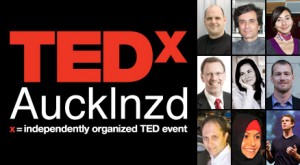
This is my experience of the afternoon at TEDx Auckland, my experience of the morning is outlined in the previous post.
Session 3
After lunch we got to hear from a band called Five Mile Town performing their song The Lucky Ones. I enjoyed it, but not being the musical sort I will let others, more musically literate, tell you what they were like.
Inspiration Wherever You Are -The 100 Days Project
I found Emma Rogan’s presentation on the 100 days project fascinating,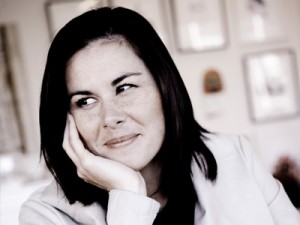 and I am still wondering how I might take part in the project. I also feel that it is something that would be of great benefit to some of my friends.
and I am still wondering how I might take part in the project. I also feel that it is something that would be of great benefit to some of my friends.
Emma is a partner at Auckland design company Apropos. Her job is creativity. Obviously this is something that she loves but it is also something that is difficult to maintain on a continuous basis. Looking for ways to exercise her ‘creative muscles’ and seek out inspiration Emma would find herself visiting New York city… on her laptop.
It was here she came across a project suggested by an arts professor in a top educational institute in the city. Emma decided to borrow the project and do it over here. But she also wanted to have some support and so she got a number of people to join in on the project with her.
The idea is simple: for 100 days, each day you must create something and record it. At the end of the period the creations will be shared.
The people who joined in on the project had a wide range of mediums and ideas. From the photographer who took a self portrait each day, to the young child who drew a different monster each day, to the film maker who filmed a moment in their young son’s life to the typographer that created a symbol or character in a different way each day, to the Mother and Daughter who took a photo of each other each day.
One of the more powerful aspects of the project challenge is element the constraint. For example the self portrait person, made the constraint that the image should never show her face. This meant that she had to ‘play’ with some serious creativity to get around this hurdle. I certainly encourage you to check out the site 100daysproject.co.nz and see what people have done in the past.
One of my favourite quotes from the presentation was Emma saying that it was fun watching children who participated: “Kids don’t over think creativity. If they get stuck they just run outside or have a biscuit. They come back to it later.”
The Mind Leading the Blind
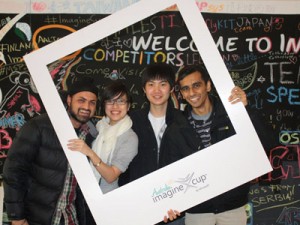 The Mobile-Eye team were represented by two young people; Jade Tan Swea Phin, and Aakash Polra who took turns explaining and demonstrating their technology.
The Mobile-Eye team were represented by two young people; Jade Tan Swea Phin, and Aakash Polra who took turns explaining and demonstrating their technology.
The concept is quite simple. The smartphones that contain a camera are almost ubiquitous these days. So these students have got together to create software that can help blind people.
There are two aspects to Mobile-Eye; Automatic and Helper (manual). From the main interface the program tells you (out loud) which direction to swipe the screen for each of the options available. If you select automating mode, you can then select colour or label. You take a photo of the object you need to know about, and the program speaks an answer to you.
In the demonstration a photo was taken of a can of dog food and a can of baked beans, a photo was taken of them side by side, and the program successfully identified which was which on the left & right. -I couldn’t help but wonder how the blind person was going to figure out which ‘side’ of the can had the main label with the description on it. The same thing can be done with colours, as their user group surveys explained that getting matching socks is an important issue.
Admittedly there are a few shortfalls with the automated program at present, but the system is being designed to learn as it goes along. But what is looking good initially was theHelper interface where the photo is sent to a volunteer’s phone or computer who then texts back a message of what they are looking at. The text is spoken at the other end.
Again I couldn’t help but speculate that this would be an ideal situation for a sort of symbiotic relationship between people with different disabilities. If someone was sighted but unable to move, they would be a perfect helper partner for someone unsighted but mobile. Mobile-Eye is asking for helper volunteers now at mobileeye.org simply register to be a blind buddy by clicking the link at the top right of that page.
It is inspiring to see people of this age creating this sort of technology!
Big Data & the Rise of Augmented Intelligence
Given my current work in data for communications and marketing,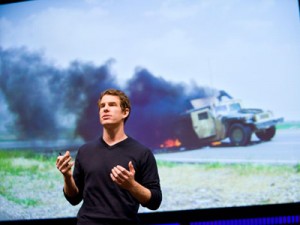 and having looked at Big Data in some depth I figured I would find this quite a simple topic. However it was not what I was expecting.
and having looked at Big Data in some depth I figured I would find this quite a simple topic. However it was not what I was expecting.
Sean Gourley started talking about how Galaga always used to beat him as a kid because he could only think and react at in 100 Milli-seconds, and computers can ‘think’ much faster than that. Then he suggested that we can out-think computers strategically, and told the story of the chess computers that finally beat chess Grand Master Garry Kasperov in 1996, two games to one.
This led to ‘free chess’ games where teams of people and/or computers were matched to play each other online. Effectively there seemed to be two types of entry those that were all computer (no human) and those that were a mix of man and machine. It was only the mixed teams that got to the semi-finals.
The remaining four teams were made up of three Grand Masters each using computers, and a mystery fourth team who also were made up of people using machines. Everyone was very curious who this fourth team was, but they did not give out their identity until after they had won the competition. It turns out that the team was made up of a football coach, and a young kid, both amateur chess players, with a borrowed home computer. The secret to their success was not their knowledge of chess, their secret was knowing when to listen to the computer and when not to.
This really set the scene for Sean to explain that humans are very good at pattern recognition. The key thing that experts have in their mind is the interrelations of various pieces of data. But experts spend a lot of time ‘learning’ the data that gives them this ability to quickly identify and act on emerging patterns from their experience.
What Sean is trying to do with his company Quid is to create a graphical malleable database which can be loaded much quicker than any expert can learn all the material. And the data can then be played with an a variety of formats within the tool to allow a person to quickly perceive patterns, looking at the mapped interrelations rather than having to spend years learning them.
Augmeted intelligence is utilising the best aspects of the human brain and computers in concert.
The Label Libel – A New Look at Diversity
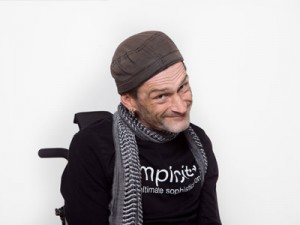 This was another crowd favourite on the day, if talk at the after-party was anything to go by. Phillip Patston’s presentation was certainly one of my favourites.
This was another crowd favourite on the day, if talk at the after-party was anything to go by. Phillip Patston’s presentation was certainly one of my favourites.
His presentation started with a very cool little film (embedded below – Thanks Phillip for firing the url through!), and then Phillip came out in his motorised wheel chair. I admit that initially it was somewhat difficult to understand his slurred speech and I wondered if I would manage to follow along.
Here is the intro Video:
But happily we soon clicked into it and easily understood what he was saying. (It wasn’t just me, I asked the question of others and they had the same experience). Phillip was talking about labels in a very humorous and thought-provoking way.
Again I feel a bit at a loss to be able to get this across to you in a way even close to the power with which Phillip presented it. When he was talking about the labels that were placed on him at certain points of his life I was compelled to send out this tweet:
#TEDxAKL “labels create a black & white world” -a male gay disabled social working entertainer
— Chris Hanlon (@theprofitwizard) October 6, 2012
It probably doesn’t sound very nice or even very coherent, but if you saw the presentation you would understand. But I was really impressed with the depth at which Phillip had thought this out, his ability to put this message across clearly and with humour, and really get stuck in my head. I particularly like this thought which is not verbatim but in my words:
“Never stop asking questions of who you are and who others are. When you stop asking questions, then you will believe you have answers. What you really have are labels.”
Here is Philip’s full presentation:
Session 4
Pull No Punches
This was another song, this time by Seth Haapu, to start off the final session. It was good timing having these lighter interludes after so much mental nutrition. In fact one of my friends tweeted in this break:
My brain has almost reached the point of exploding from the awesomeness at #TEDxAkl. Must. Survive. Last. Few. Talks.
— Jason Lerke ? (@5hameless) October 6, 2012
The Wall -Making History Social
Victoria Spackman introduced us to one of the technology powerhouses 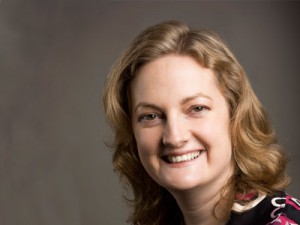 of New Zealand, of which I was totally oblivious, The Gibson Group, of which Victoria is CEO.
of New Zealand, of which I was totally oblivious, The Gibson Group, of which Victoria is CEO.
She explained that their goal was to make museum contents more accessible to the general public. And I have to admit when she talked about the storage versus display issue that museums face it was a blast from the past.
Museums have an obligation to display pieces of culture so that visitors can learn and be enriched by them. But they also have an obligation to protect and preserve items for the enjoyment and enrichment of future generations. Unfortunately preservation and display are often at odds with each other.
I experienced this as a child. My grandmother was a warder at the Wellington Museum, and my brother and I often helped her close up at the end of the day. Turning the lights off in the mummy room was an act of extreme bravery, but my favourite part was locking up in the lower levels where people couldn’t see. We would walk through a room with the bones of a blue whale around us, we were literally walking down it’s gullet (or where it would be if it wasn’t just a skeleton). The storage and preservation rooms of the museum was a magical place for a young boy. <ahem>
But back to Victoria and her wall. What followed was one of the most entrancing demonstrations I have witnessed. she showed a miniature representation of the installation the Gibson Group had done for Copenhagen in Denmark. It was enchanting, and I believe everyone in the room was itching to give it a go.
Funny enough I now realise i had given it a go, at least one of it’s predecessors. I tweeted that it was a shame these installations are all being exported, I’d love to see one in New Zealand. I got a reply that the Gibson Group did do a wall for Te Papa. Which of course I did visit with a friend and spent some time playing with it. It was incredibly popular. -I was not when I took her photo and replicated it across the entire wall
The Lowdown on Infrasound
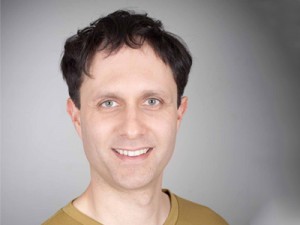 Matthew Simmons was the perfect speaker for this time of the day. His story was light, interesting and amusing. I am sure most of the guys in the room wanted to have a job like Matthew, or at least get to play with the things he does. Big BIG speakers.
Matthew Simmons was the perfect speaker for this time of the day. His story was light, interesting and amusing. I am sure most of the guys in the room wanted to have a job like Matthew, or at least get to play with the things he does. Big BIG speakers.
His stories were great like the one about creating the Bladder Buster sub woofer for a show, selling it to a customer in Texas who was so proud of it, the team sent him monogrammed adult diapers for his birthday.
My ears perked up when he said “Give me one task and I will never get it done, but give me four or five and I will happily juggle them to completion”. I wonder if that is a philosophy I should be living by? It certainly sounds familiar.
His relocation from a shaking Christchurch meant he had to start his business all over again and he returned to the idea of using infra sound (very low frequency sound waves) to scare birds away. This enables him to pursue the ability to create an exclusion zone for birds at either end of a runway. Playing with infrasound also enabled Matthew to stumble on the ability to use infrasound in mapping and measuring geological topography.
-To be honest at this point I don’t think my mind was taking in a lot of information so I can’t give you much detail of the scientific bit and this wasn’t helped by the fact my pencil had run out of lead. I resorted to a pen, but pens are notorious for stopping and starting…
Reinventing Reading
Paul Cameron’s presentation was possibly the most 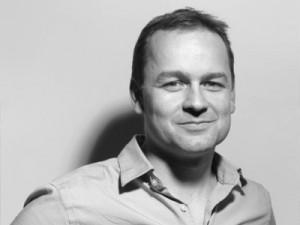 controversial in discussions between delegates. Some loved the technology he demonstrated, some struggled to decide what to think of it, and a few had serious reservations.
controversial in discussions between delegates. Some loved the technology he demonstrated, some struggled to decide what to think of it, and a few had serious reservations.
Paul started by saying that reading was having a crisis. He shared some stats that really did make you wonder. Such as: Children in the United Kingdom are more likely to own a mobile phone than a book. Or: In 2009 89% of families didn’t buy a single book.
Those statements absolutely blew me away. But then I am an avid reader. With my kindle I probably buy a book every week. I am usually reading more than one book at a time (mostly non-fiction) but if I really want to relax I can read a couple of novels in a weekend.
However Paul believes that the answer to this trend away from reading is to add a soundtrack to the books themselves in an immersive way. The technology that he described and then demonstrated was very very good. So good that it seemed effortless. But I have some idea of how challenging it must have been to get that technology right.
Before the demonstration I was quite skeptical. Sure it would be good for the TV generation who didn’t like books, but it wouldn’t be of any interest to me, I love reading. But after the demonstration I figured I should definitely give this a go, and see how it works for me. Paul claims that booktrack helps people get ‘into’ the book more quickly and they are less easily distracted.
What is really interesting and worth paying attention to is the fact that Booktrack is being created as opensource and the tools to create booktracks for your own books will be freely available. Given the explosion in ebooks with Amazon and Kindle leading the charge I wonder what impact this might have with these new distribution platforms? As a publisher and an author I am going to be watching this carefully.
The Last Ocean
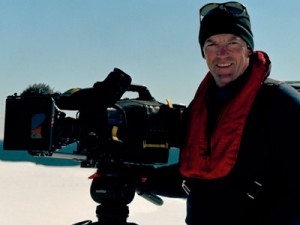 It was amusing to see the discomfort that Peter Young had standing on stage addressing us, when he muttered he would never again ask an actor in front of his camera to “just act natural”… it is just not possible!
It was amusing to see the discomfort that Peter Young had standing on stage addressing us, when he muttered he would never again ask an actor in front of his camera to “just act natural”… it is just not possible!
However Peter soon relaxed into his topic, and again the choice of placement of speakers was superb. Peter’s presentation featured a lot of film imagery from his recent feature length documentary; The Last Ocean. Mostly he spoke while hauntingly beautiful images of Antarctica, the sea life, and of course the irrepressible penguins paraded one by one across the screen.
One fact I scribbled down was that one of the penguin colonies he filmed had been there for 15,000 years. -Just pause for a minute and think about that. Man has not impacted those penguins in all that time, until now.
I was amazed and alarmed to hear that the treaty which made Antarctica a scientific preserve did not include the waters around the continent. I had always assumed that, like any country, there would be a certain number of miles off the coast that was included.
It is extremely disappointing to hear that it was the New Zealand fishing industry that brought theinnovation of fishing Antarctic waters to the rest of the world, and now fishing vessels from many countries are pulling fish from the region. One of the most sought after fish is the Antarctic toothfish. This fish was studied at some length 20 years ago. At that time catch and release scientific tagging programs would routinely pull 400-500 toothfish. Now the average is 3-4 toothfish.
Peter did offer some hope though. A call to action. In Hobart this year is a treaty slated to be signed to make certain zones of the Antarctic no-fishing zones. However the government of New Zealand have included the Ross sea as a fishing zone, because we routinely send our fishing fleets in there. Peter believes that the Ross sea should remain an intact marine preserve.
If you believe, as Peter and I do, that we need to preserve this, the last pristine marine eco-system on our planet for future generations, then I urge you to go to his website and click on the button to send a message to the Prime Minister of New Zealand. -It is a quick and painless process that could make the world of difference to your children and grandchildren.
The After Party
TED and TEDx is much more than a bunch of interesting people on stage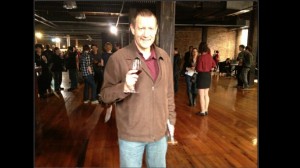 or in front of a camera. It is a community. It is all about people who share what they know and what the think and what they feel. It isn’t one-way traffic, and it could never be that way.
or in front of a camera. It is a community. It is all about people who share what they know and what the think and what they feel. It isn’t one-way traffic, and it could never be that way.
So the after party, and networking in the breaks, is a huge part of the TEDx experience. I got to meet a few of the speakers, I met some fascinating attendees, and I know I will be catching up with some of these people in the future.
The venue was fantastic. -My one suggestion for next year is to include a map… Both Google maps and Apple maps seem to be ignorant of a ‘Galway’ street in central Auckland and suggested I walk to Onehunga. Fortunately FourSquare rescued me, when 60 people check in to an art gallery on a Saturday evening, it is a pretty big clue!
I hope you enjoyed my rundown of the event. If I have made any factual errors you feel need correcting let me know. If you had a different experience, (or the same experience), leave a comment below to let others know.
Hopefully I will see you next year at TEDx Auckland 2013 #TEDxAkl
Another cool post:
TEDx Auckland- It’s never over
You may want to see my previous posts on TEDx Auckland:


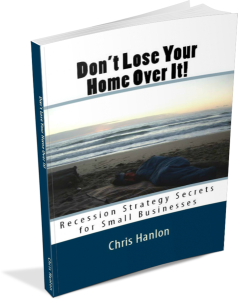





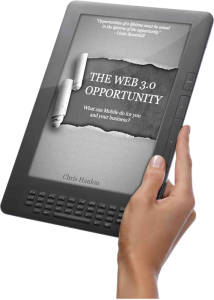
Trackbacks/Pingbacks
[…] Continue to Part Two – The Afternoon Sessions […]
[…] TEDx Auckland 2012 -part 1 TEDx Auckland 2012 -part 2 […]